Promoting Interfacial Interactions with the Addition of Lignin in Poly(Lactic Acid) Hybrid Nanocomposites
Abstract
:1. Introduction
2. Materials and Methods
2.1. Preparation of PLA/Lignin Hybrid Nanocomposites
2.2. Field-Emission Scanning-Electron Microscopy (FESEM) and Transmission-Electron Microscopy (TEM)
2.3. Thermogravimetric Analysis (TGA)
2.4. Modulated Temperature-Differential Scanning Calorimetry (MT-DSC)
2.5. Cooperative Rearranging Regions (CRR)
3. Results and Discussion
4. Conclusions
Author Contributions
Funding
Institutional Review Board Statement
Informed Consent Statement
Data Availability Statement
Acknowledgments
Conflicts of Interest
References
- Badia, J.D.; Ribes-Greus, A. Mechanical recycling of polylactide, upgrading trends and combination of valorization techniques. Eur. Polym. J. 2016, 84, 22–39. [Google Scholar] [CrossRef] [Green Version]
- Tsuji, H.; Yamamoto, S.; Okumura, A. Homo- and hetero-stereocomplexes of substituted poly(lactide)s as promising biodegradable crystallization–accelerating agents of poly(L–lactide). J. Appl. Polym. Sci. 2011, 122, 321–333. [Google Scholar] [CrossRef]
- Bhardwaj, R.; Mohanty, A.K. Modification of brittle polylactide by novel hyperbranched polymer-based nanostructures. Biomacromolecules 2007, 8, 2476–2484. [Google Scholar] [CrossRef] [PubMed] [Green Version]
- Azizi, S.; Azizi, M.; Sabetzadeh, M. The role of multiwalled carbon nanotubes in the mechanical, thermal, rheological, and electrical properties of PP/PLA/MWCNTs nanocomposites. J. Compos. Sci. 2019, 3, 64. [Google Scholar] [CrossRef] [Green Version]
- Trifol, J.; Plackett, D.; Sillard, C.; Szabo, P.; Bras, J.; Daugaard, A.E. Hybrid poly(lactic acid)/nanocellulose/nanoclay composites with synergistically enhanced barrier properties and improved thermomechanical resistance. Polym. Int. 2016, 65, 988–995. [Google Scholar] [CrossRef] [Green Version]
- Molinaro, S.; Romero, M.C.; Boaro, M.; Sensidoni, A.; Lagazio, C.; Morris, M.; Kerry, J. Effect of nanoclay-type and PLA optical purity on the characteristics of PLA–based nanocomposite films. J. Food Eng. 2013, 117, 113–123. [Google Scholar] [CrossRef]
- Arriagada, P.; Palza, H.; Palma, P.; Flores, M.; Caviedes, P. Poly(lactic acid) composites based on graphene oxide particles with antibacterial behavior enhanced by electrical stimulus and biocompatibility. J. Biomed. Mater. Res. A 2018, 106, 1051–1060. [Google Scholar] [CrossRef]
- Mina, M.F.; Beg, M.D.H.; Islam, M.R.; Nizam, A.; Alam, A.K.M.M.; Yunus, R.M. Structures and properties of injection-molded biodegradable poly(lactic acid) nanocomposites prepared with untreated and treated multiwalled carbon nanotubes. Polym. Eng. Sci. 2014, 54, 317–326. [Google Scholar] [CrossRef] [Green Version]
- Doherty, W.O.; Mousavioun, P.; Fellows, C.M. Value–adding to cellulosic ethanol: Lignin polymers. Ind. Crops Prod. 2011, 33, 259–276. [Google Scholar] [CrossRef] [Green Version]
- Chen, J.; Liu, C.; Wu, S.; Liang, J.; Lei, M. Enhancing the quality of bio–oil from catalytic pyrolysis of kraft black liquor lignin. RSC Adv. 2016, 6, 107970–107976. [Google Scholar] [CrossRef]
- Ragauskas, A.J.; Beckham, G.T.; Biddy, M.J.; Chandra, R.; Chen, F.; Davis, M.F.; Davison, B.H.; Dixon, R.A.; Gilna, P.; Keller, M.; et al. Lignin valorization: Improving lignin processing in the biorefinery. Science 2014, 344, 1246843. [Google Scholar] [CrossRef] [PubMed]
- Park, C.W.; Youe, W.J.; Han, S.Y.; Kim, Y.S.; Lee, S.H. Characteristics of carbon naonfibers produced from lignin/polyacrylonitrile (PAN)/kraft lignin–g–PAN copolymer blends electrospun nanofibers. Holforschung 2017, 71, 746–750. [Google Scholar] [CrossRef]
- Baker, D.A.; Rials, T.G. Recent advance in low-cost carbon fiber manufacture from lignin. J. Appl. Polym. Sci. 2013, 130, 713–728. [Google Scholar] [CrossRef]
- Spiridon, I.; Leluk, K.; Resmerita, A.M.; Darie, R.N. Evaluation of PLA–lignin bioplastics properties before and after accelerated weathering. Compos. Part B Eng. 2015, 69, 342–349. [Google Scholar] [CrossRef]
- Sahoo, S.; Misra, M.; Mohanty, A.K. Enhanced properties of lignin–based biodegradable polymer composites using injection moulding process. Compos. Part A Appl. S. 2011, 42, 1710–1718. [Google Scholar] [CrossRef]
- Chung, Y.-L.; Olsson, J.V.; Li, R.J.; Frank, C.W.; Waymouth, R.M.; Billington, S.L.; Sattely, E.S. A renewable lignin–lactide copolymer and application in biobased composites. ACS Sustain. Chem. Eng. 2013, 1, 1231–1238. [Google Scholar] [CrossRef]
- Sun, Y.; Yang, L.; Lu, X.; He, C. Biodegradable and renewable poly(lactide)–lignin composites: Synthesis, interface and toughening mechanism. J. Mater. Chem. A 2015, 3, 3699–3709. [Google Scholar] [CrossRef]
- Tanase-Opedal, M.; Espinosa, E.; Rodríguez, A.; Chinga-Carrasco, G. Lignin: A biopolymer from forestry biomass for biocomposites and 3D printing. Materials 2019, 12, 3006. [Google Scholar] [CrossRef] [Green Version]
- Cauley, A.N.; Wilson, J.N. Functionalized lignin biomaterials for enhancing optical properties and cellular interactions of dyes. Biomater. Sci. 2017, 5, 2114–2121. [Google Scholar] [CrossRef]
- Privas, E.; Leroux, F.; Navard, P. Preparation and properties of blends composed of lignosulfonated layered double hydroxide/plasticized starch and thermoplastics. Carbohyd. Polym. 2013, 96, 91–100. [Google Scholar] [CrossRef]
- Chupin, L.; Charrier, B.; Pizzi, A.; Perdomo, A.; Charrier–El Bouhtoury, F. Study of thermal durability properties of tannin–lignosulfonate adhesives. J. Therm. Anal. Calorim. 2015, 119, 1577–1585. [Google Scholar] [CrossRef]
- Graupner, N. Application of lignin as natural adhesion promoter in cotton fibre–reinforced poly(lactic acid) (PLA) composites. J. Mater. Sci. 2008, 43, 5222–5229. [Google Scholar] [CrossRef]
- Chen, K.; Wilkie, C.A.; Vyazovkin, S. Nanoconfinement revealed in degradation and relaxation studies of two structurally different polystyrene–clay systems. J. Phys. Chem. B 2007, 111, 12685–12692. [Google Scholar] [CrossRef] [PubMed]
- Saiter, A.; Couderc, H.; Grenet, J. Characterisation of structural relaxation phenomena in polymeric materials from thermal analysis investigations. J. Therm. Anal. Cal. 2007, 88, 483–488. [Google Scholar] [CrossRef]
- Leszczynska, A.; Pielichowski, K. Application of thermal analysis methods for characterization of polymer/montmorillonite nanocomposites. J. Therm. Anal. Calorim. 2007, 93, 677–687. [Google Scholar] [CrossRef]
- Greco, A.; Gennaro, R.; Rizzo, M. Glass transition and cooperative rearranging regions in amorphous thermoplastic nanocomposites. Polym. Int. 2012, 61, 1326–1333. [Google Scholar] [CrossRef]
- Yousefzade, O.; Garmabi, H.; Puiggali, J. Cooperative rearranging region and dynamical heterogeneity of nanocomposites in poly(l-lactide) and functionalized carbon nanotubes systems. Thermochim. Acta 2018, 667, 35–41. [Google Scholar] [CrossRef]
- Khan, A.N.; Hayder, A.; Chaung, W.-T.; Hong, P.-D. Glass transition behavior of poly(trimethylene 2,6-naphthalate) in nanoclay confinement. Polym. Sci. Ser. A 2015, 57, 874–882. [Google Scholar] [CrossRef]
- Sharma, M.; Madras, G.; Bose, S. Cooperativity and structural relaxations in PVDF/PMMA blends in the presence of MWNTs: An assessment through SAXS and dielectric spectroscopy. Macromolecules 2014, 47, 1392–1402. [Google Scholar] [CrossRef]
- Patanair, B.; Thomas, S.; Abitha, V.K.; Saiter–Fourcin, A. Confinement effects at nanoscale in natural rubber composites: Influence on macroscopic properties. J. App. Polym. Sci. 2020, 138, 49838. [Google Scholar] [CrossRef]
- Donth, E. The size of cooperatively rearranging regions at the glass transition. J. Non-Cryst. Solids 1982, 53, 325–330. [Google Scholar] [CrossRef]
- Hempel, E.; Hempel, G.; Hensel, A.; Schick, C.; Donth, E. Characteristic length of dynamic glass transition near tg for a wide assortment of glass-forming substances. J. Phys. Chem. B 2000, 104, 2460–2466. [Google Scholar] [CrossRef]
- Adam, G.; Gibbs, J.H. On the temperature dependence of cooperative relaxation properties in glass–forming liquids. J. Chem. Phys. 1965, 43, 139. [Google Scholar] [CrossRef] [Green Version]
- Saiter, A.; Delpouve, N.; Dargent, E.; Oberhauser, W.; Conzatti, L.; Cicogna, F.; Passaglia, E. Probing the chain segment mobility at the interface of semi-crystalline polylactide/clay nanocomposites. Eur. Polym. J. 2016, 78, 274–289. [Google Scholar] [CrossRef]
- Wurm, A.; Ismail, M.; Kretzschmar, B.; Pospiech, D.; Schick, C. Retarded crystallization in polyamide/layered silicates nanocomposites caused by an immobilized interphase. Macromolecules 2010, 43, 1480–1487. [Google Scholar] [CrossRef]
- Aliotta, L.; Gazzano, M.; Lazzeri, A.; Righetti, M.C. Constrained amorphous interphase in poly(l-lactic acid): Estimation of the tensile elastic modulus. ACS Omega 2020, 5, 20890–20902. [Google Scholar] [CrossRef]
- Fernandes Nassar, S.; Guinault, A.; Delpouve, N.; Divry, V.; Ducruet, V.; Sollogoub, C.; Domenek, S. Multi-scale analysis of the impact of polylactide morphology on gas barrier properties. Polymer 2017, 108, 163–172. [Google Scholar] [CrossRef]
- Klonos, P.A.; Peoglos, V.; Bikiaris, D.N.; Kyritsis, A. Rigid amorphous fraction and thermal diffusivity in nanocomposites based on poly(l–lactic acid) filled with carbon nanotubes and graphene oxide. J. Phys. Chem. C 2020, 124, 5469–5479. [Google Scholar] [CrossRef]
- Akhina, H.; Gopinathan Nair, M.R.; Kalarikkal, N.; Pramoda, K.P.; Ru, T.H.; Kailas, L.; Thomas, S. Plasticized PVC graphene nanocomposites: Morphology, mechanical, and dynamic mechanical properties. Polym. Eng. Sci. 2017, 58, 858–865. [Google Scholar] [CrossRef]
- Lacey, A.A.; Price, D.M.; Reading, M. Theory and practice of modulated temperature differential scanning calorimetry. In Modulated Temperature Differential Scanning Calorimetry; Reading, M., Hourston, D.J., Eds.; Springer: Dordrecht, The Netherlands, 2006; Volume 6, pp. 1–81. [Google Scholar] [CrossRef] [Green Version]
- Varol, N.; Delpouve, N.; Araujo, S.; Domenek, S.; Guinault, A.; Golovchak, R.; Ingram, A.; Delbreilh, L.; Dargent, E. Amorphous rigidification and cooperativity drop in semi–crystalline plasticized polylactide. Polymer 2020, 194, 122373. [Google Scholar] [CrossRef]
- Dobircau, L.; Delpouve, N.; Herbinet, R.; Domenek, S.; Le Pluart, L.; Delbreilh, L.; Ducruet, V.; Dargent, E. Molecular mobility and physical ageing of plasticized poly(lactide). Polym. Eng. Sci. 2015, 55, 858–865. [Google Scholar] [CrossRef]
- Ma, Z.; Sun, Q.; Ye, J.; Yao, Q.; Zhao, C. Study on the thermal degradation behaviors and kinetics of alkali lignin for production of phenolic-rich bio-oil using TGA–FTIR and Py–GC/MS. J. Anal. Appl. Pyrol. 2016, 117, 116–124. [Google Scholar] [CrossRef]
- Gordobil, O.; Delucis, R.; Egüés, I.; Labidi, J. Kraft lignin as filler in PLA to improve ductility and thermal properties. Ind. Crops Prod. 2015, 72, 46–53. [Google Scholar] [CrossRef]
- Ferreira, W.H.; Andrade, C.T. The role of graphene on thermally induced shape memory properties of poly(lactic acid) extruded composites. J. Therm. Anal. Calorim. 2020, 1–9. [Google Scholar] [CrossRef]
- Hu, C.; Li, Z.; Wang, Y.; Gao, J.; Dai, K.; Zheng, G.; Liu, C.; Shen, C.; Song, H.; Guo, Z. Comparative assessment of the strain-sensing behaviors of polylactic acid nanocomposites: Reduced graphene oxide or carbon nanotubes. J. Mater. Chem. C 2017, 3, 2318–2328. [Google Scholar] [CrossRef]
- Iturrondobeitia, M.; Okariz, A.; Guraya, T.; Zaldua, A.-M.; Ibarretxe, J. Influence of the processing parameters and composition on the thermal stability of PLA/nanoclay bio-nanocomposites. J. Appl. Polym. Sci. 2014, 131, 40747. [Google Scholar] [CrossRef]
- Fischer, E.W.; Sterzel, H.J.; Wegner, G. Investigation of the structure of solution grown crystals of lactide copolymers by means of chemical reactions. Kolloid Z. Z. Polym. 1973, 251, 980–990. [Google Scholar] [CrossRef]
- Barrau, S.; Vanmansart, C.; Moreau, M.; Addad, A.; Stoclet, G.; Lefebvre, J.-M.; Seguela, R. Crystallization behavior of carbon nanotube–polylactide nanocomposites. Macromolecules 2011, 44, 6496–6502. [Google Scholar] [CrossRef]
- Szymoniak, P.; Pauw, B.R.; Qu, X.; Schönhals, A. Competition of nanoparticle–induced mobilization and immobilization effects on segmental dynamics of an epoxy–based nanocomposite. Soft Matter 2020, 16, 5406–5421. [Google Scholar] [CrossRef]
- Delpouve, N.; Saiter–Fourcin, A.; Coiai, S.; Cicogna, F.; Spiniello, R.; Oberhauser, W.; Legnaioli, S.; Ishak, R.; Passaglia, E. Effects of organo-LDH dispersion on thermal stability, crystallinity and mechanical features of PLA. Polymer 2020, 208, 122952. [Google Scholar] [CrossRef]
- Klonos, P.; Terzopoulou, Z.; Koutsoumpis, S.; Zidropoulos, S.; Kripotou, S.; Papageorgiou, G.Z.; Bikiaris, D.N.; Kyritsis, A.; Pissis, P. Rigid amorphous fraction and segmental dynamics in nanocomposites based on poly(l-lactic acid) and nano-inclusions of 1-3D geometry studied by thermal and dielectric techniques. Polymer 2016, 82, 16–34. [Google Scholar] [CrossRef]
- Angell, C.A. Spectroscopy simulation and scattering, and the medium range order problem in glass. J. Non-Cryst. Solids 1985, 73, 1–17. [Google Scholar] [CrossRef]
- Delpouve, N.; Delbreilh, L.; Stoclet, G.; Saiter, A.; Dargent, E. Structural dependence of the molecular mobility in the amorphous fractions of polylactide. Macromolecules 2014, 47, 5186–5197. [Google Scholar] [CrossRef] [Green Version]
- Hong, L.; Novikov, V.N.; Sokolov, A.P. Is there a connection between fragility of glass forming systems and dynamic heterogeneity/cooperativity? J. Non-Cryst. Solids 2011, 357, 351–356. [Google Scholar] [CrossRef]
- Araujo, S.; Batteux, B.; Li, W.; Butterfield, L.; Delpouve, N.; Esposito, A.; Tan, L.; Saiter, J.-M.; Negahban, M. A structural interpretation of the two components governing the kinetic fragility from the example of interpenetrated polymer networks. J. Polym. Sci. Pol. Phys. 2018, 56, 1393–1403. [Google Scholar] [CrossRef]
- Laredo, E.; Grimau, M.; Bello, A.; Wu, D. Molecular dynamics and crystallization precursors in polylactide and poly(lactide)/CNT biocomposites in the insulating state. Eur. Polym. J. 2013, 49, 4008–4019. [Google Scholar] [CrossRef]
- Sanusi, O.M.; Papadopoulos, L.; Klonos, P.A.; Terzopoulou, Z.; Hocine, N.A.; Benelfellah, A.; Papageorgiou, G.Z.; Kyritsis, A.; Bikiaris, D.N. Calorimetric and dielectric study of renewable poly(hexylene 2,5-furan-dicarboxylate)-based nanocomposites in situ filled with small amounts of graphene platelets and silica nanoparticles. Polymers 2020, 12, 1239. [Google Scholar] [CrossRef]
- Crétois, R.; Delbreilh, L.; Dargent, E.; Follain, N.; Lebrun, L.; Saiter, J.-M. Dielectric relaxations in polyhydroxyalkanoates/organoclay nanocomposites. Eur. Polym. J. 2013, 49, 3434–3444. [Google Scholar] [CrossRef]
- Sharma, M.; Madras, G.; Bose, S. Unusual fragility and cooperativity in glass–forming and crystalline PVDF/PMMA blends in the presence of multiwall carbon nanotubes. Macromolecules 2015, 48, 2740–2750. [Google Scholar] [CrossRef]
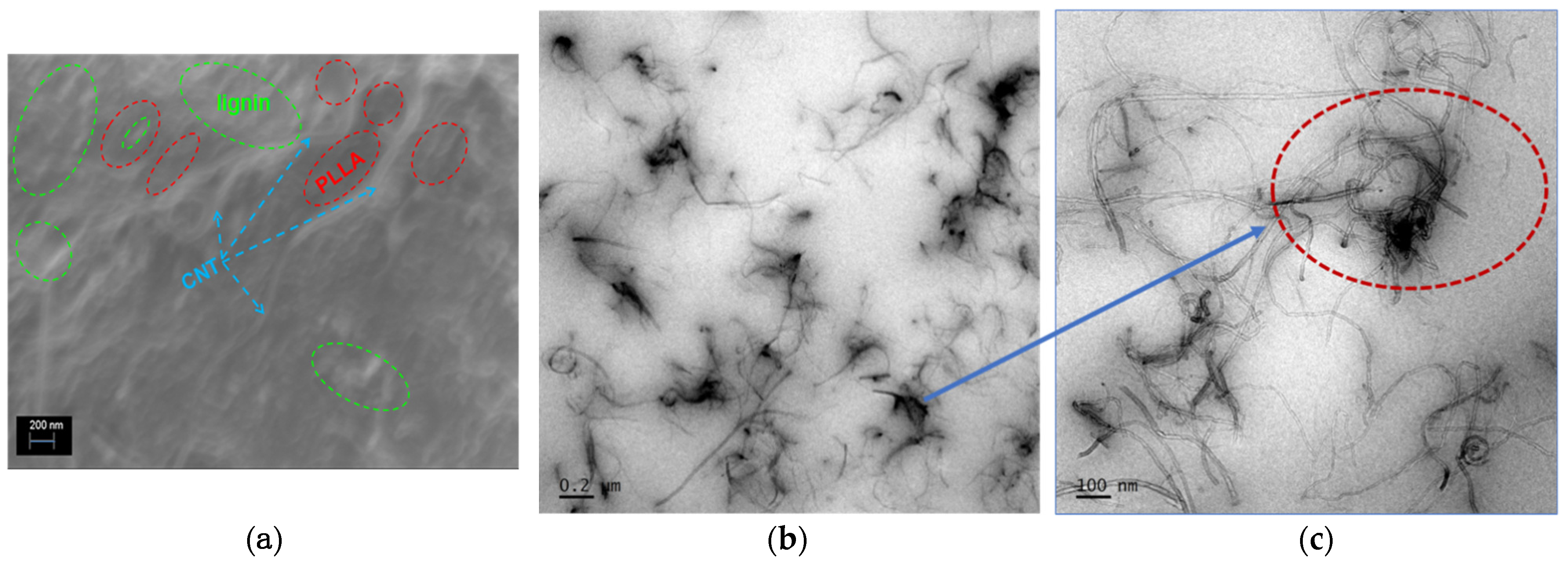
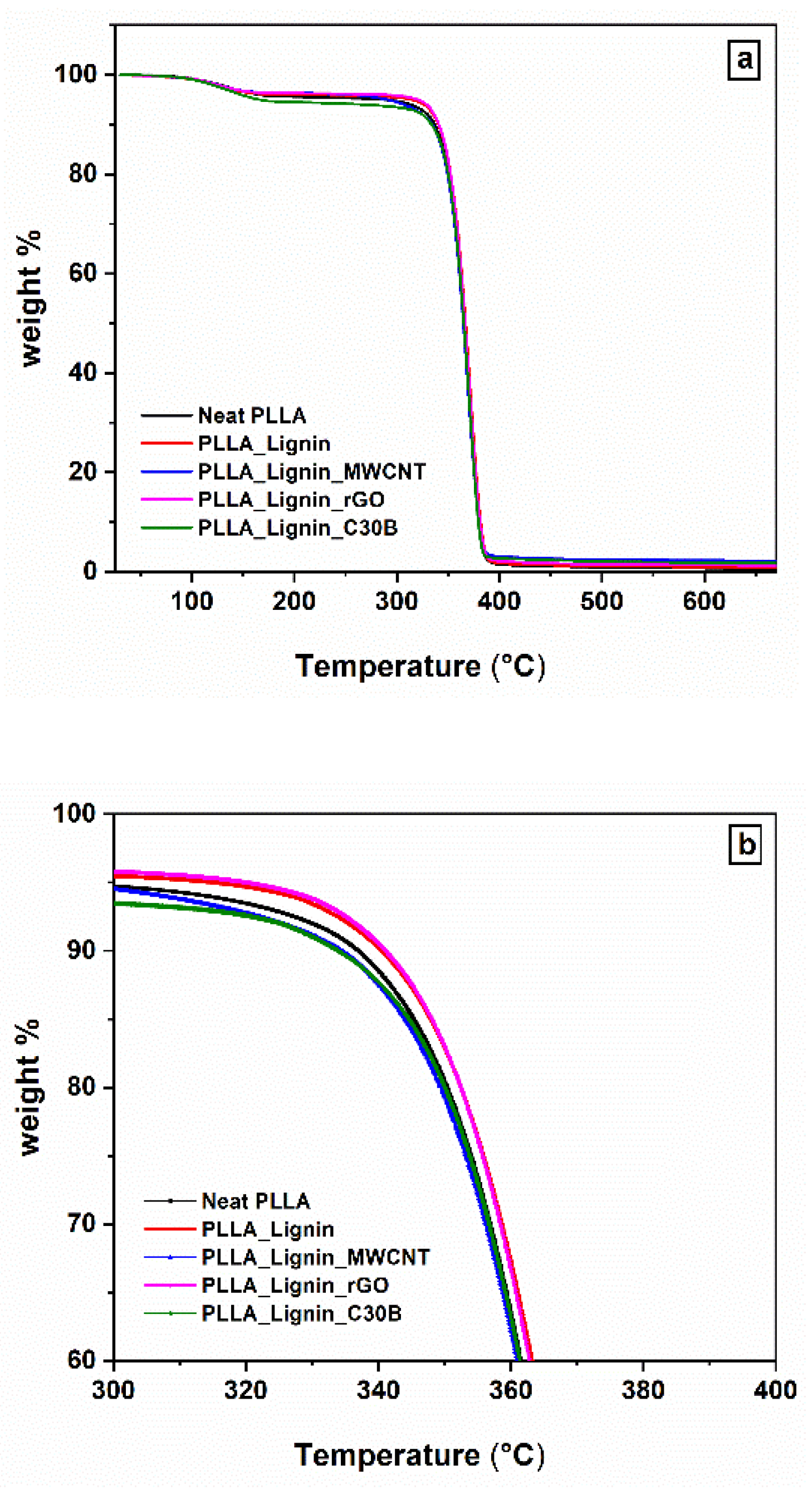
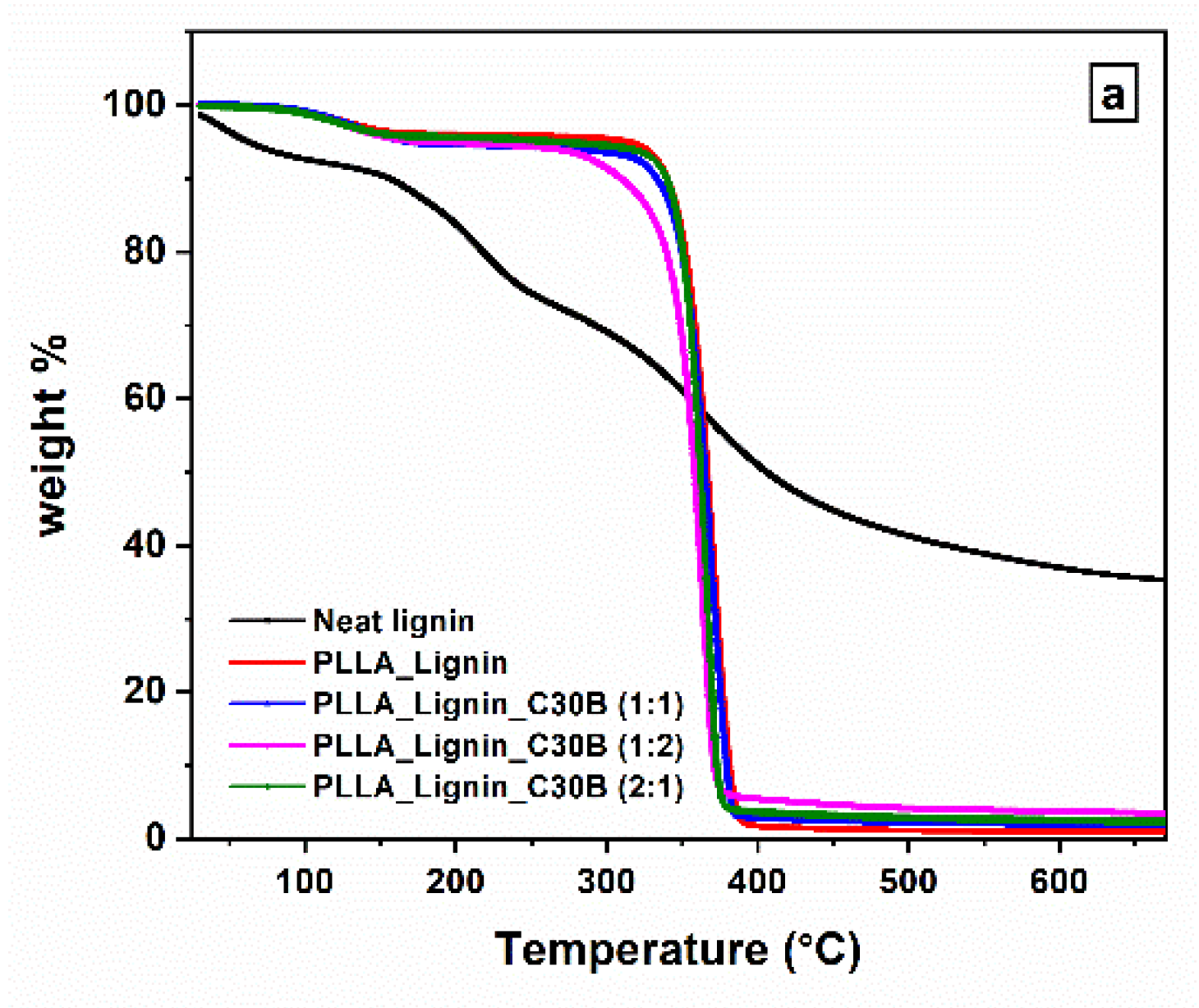
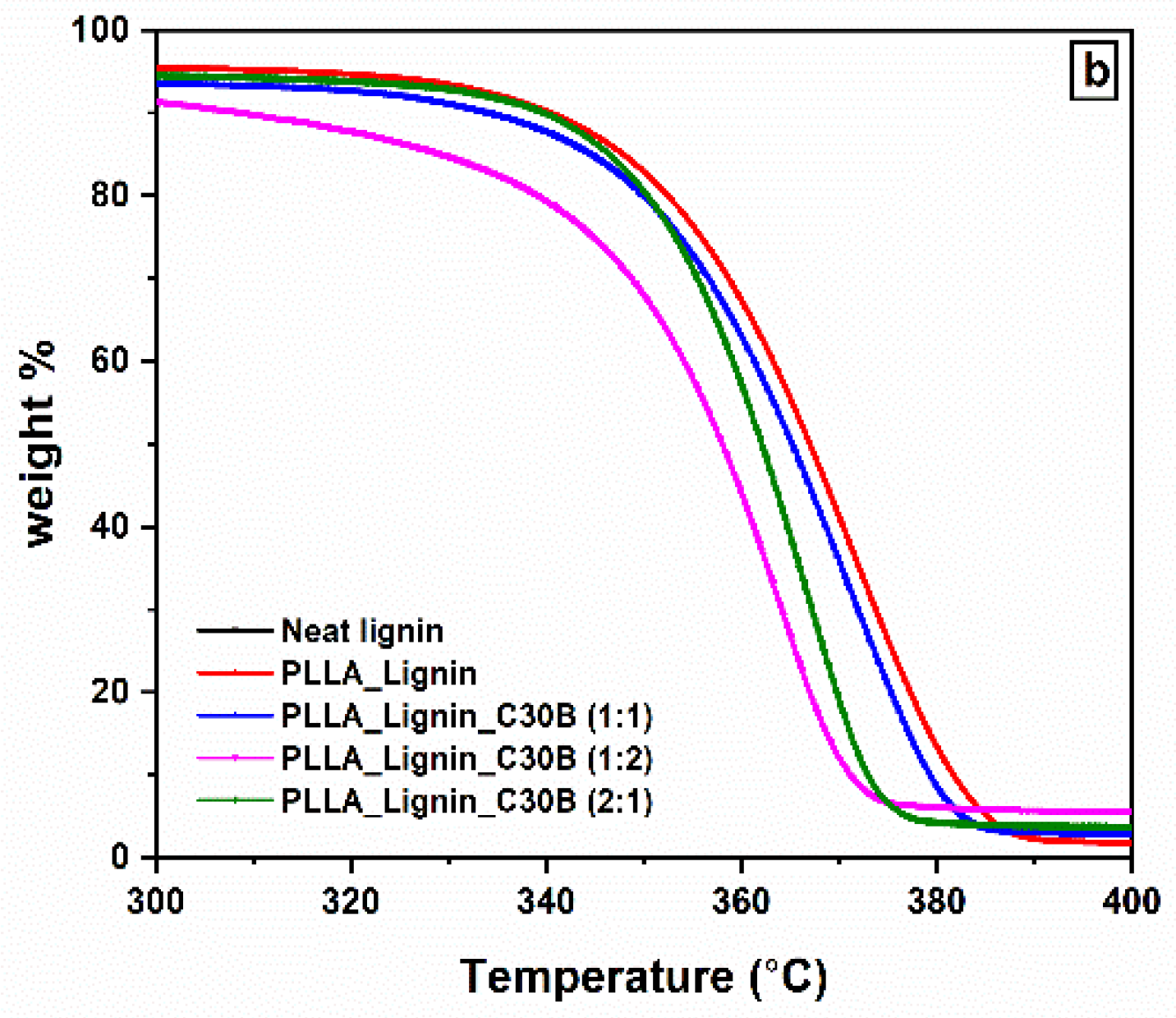
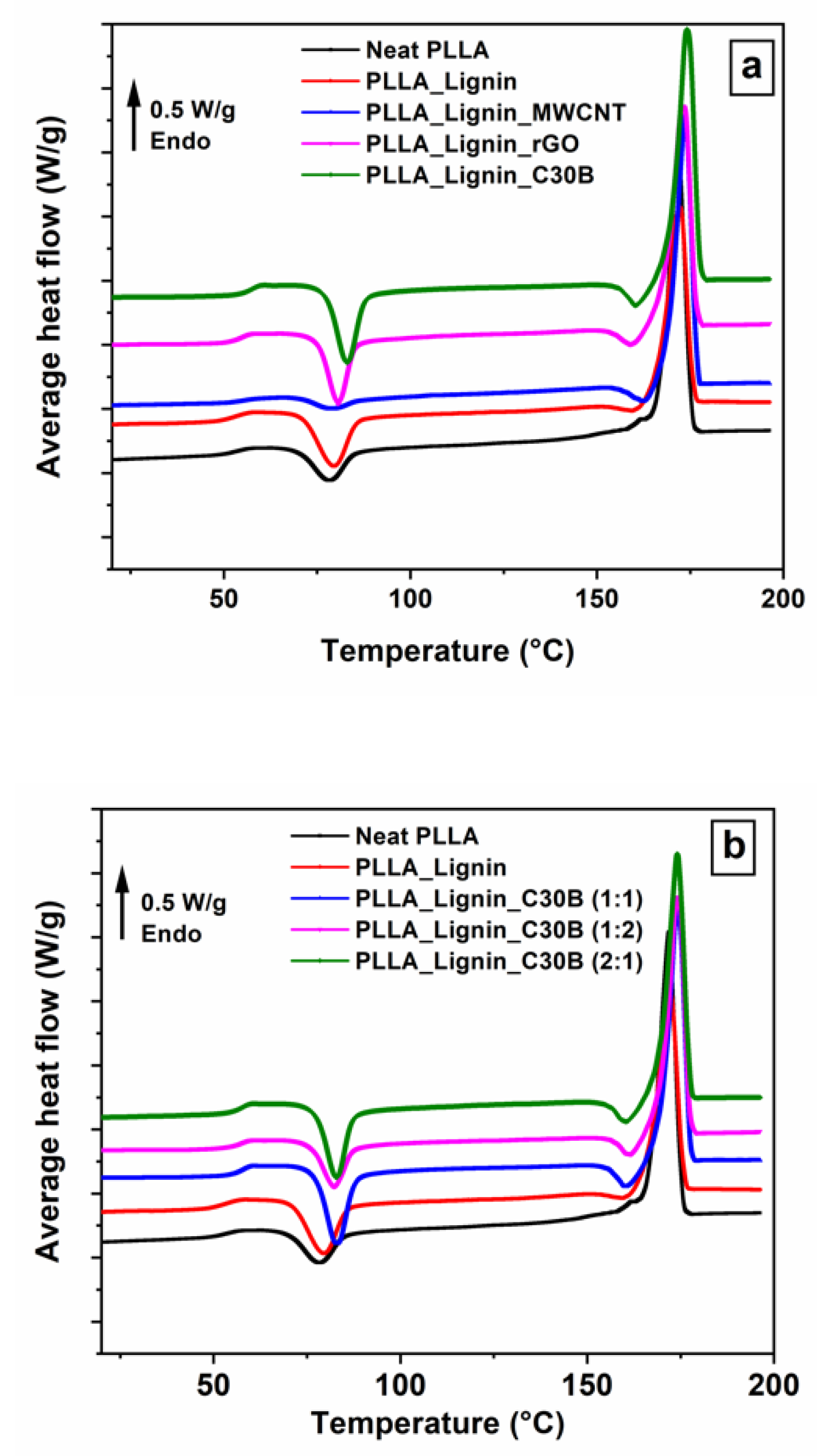
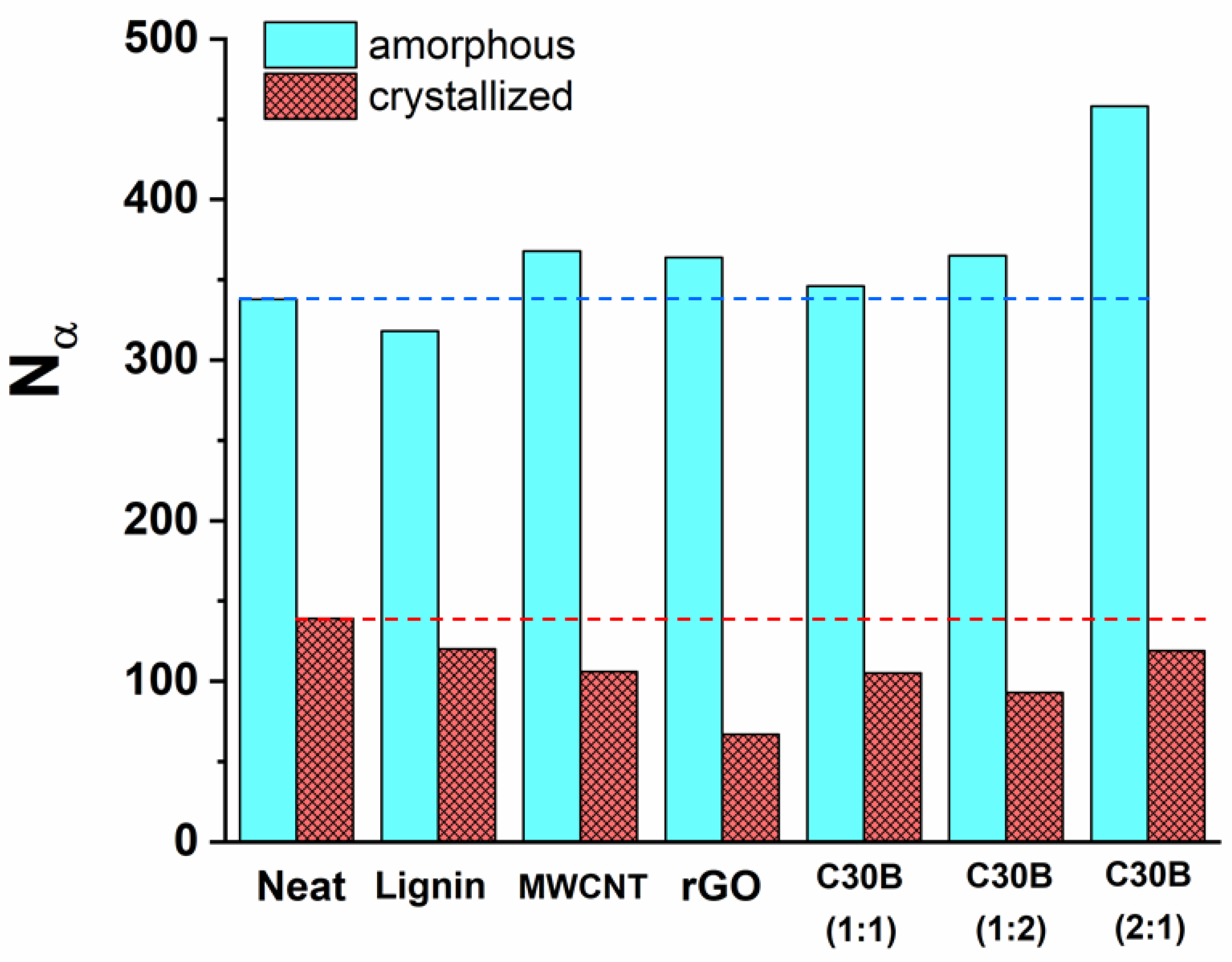

| TGA | MT–DSC | ||||||||
|---|---|---|---|---|---|---|---|---|---|
| Temperatures Corresponding to % of Weight Loss (°C) | Heat Capacity Step ΔCp (J g−1 K−1), Glass-Transition Temperature Tg (°C), Enthalpy of Cold–Crystallization ΔHc (J g−1), Degree of Crystallinity Xc (%) | ||||||||
| T5% | T10% | T50% | T90% | T95% | ΔCp | Tg | ΔHc | Xc * | |
| neat PLLA | 289 | 337 | 365 | 380 | 383 | 0.21 | 53.5 | 16 | 41 |
| PLLA_Lignin | 315 | 340 | 367 | 381 | 385 | 0.42 | 52.5 | 33 | 18 |
| PLLA_Lignin_MWCNT | 291 | 334 | 365 | 380 | 383 | 0.14 | 54.0 | 10 | 43 |
| PLLA_Lignin_rGO | 321 | 341 | 366 | 381 | 385 | 0.38 | 55.0 | 31 | 23 |
| PLLA_Lignin_C30B (1:1) | 166 | 334 | 365 | 379 | 382 | 0.43 | 56.5 | 30 | 23 |
| PLLA_Lignin_C30B (1:2) | 205 | 309 | 358 | 371 | 437 | 0.38 | 56.5 | 23 | 28 |
| PLLA_Lignin_C30B (2:1) | 270 | 340 | 362 | 373 | 377 | 0.42 | 56.5 | 29 | 21 |
| Amorphous | Semi-crystalline | |||||||||
|---|---|---|---|---|---|---|---|---|---|---|
| Tα (°C) | ΔT (°C) | ΔCp (J g−1 K−1) | Nα | Tα (°C) | ΔT (°C) | ΔCp (J g−1 K−1) | Xc * (%) | XRAF crystal ** (%) | Nα | |
| neat PLLA | 58.5 | 2.70 | 0.54 | 338 | 67.0 | 4.3 | 0.13 | 32 | 45 | 139 |
| PLLA_Lignin | 58.2 | 2.75 | 0.53 | 318 | 64.0 | 4.6 | 0.15 | 33 | 39 | 120 |
| PLLA_Lignin_MWCNT | 58.8 | 2.63 | 0.57 | 368 | 64.6 | 5.0 | 0.17 | 30 | 39 | 106 |
| PLLA_Lignin_rGO | 58.4 | 2.70 | 0.60 | 364 | 65.0 | 6.4 | 0.16 | 33 | 40 | 67 |
| PLLA_Lignin_C30B (1:1) | 59.2 | 2.68 | 0.54 | 346 | 67.2 | 4.9 | 0.18 | 31 | 35 | 105 |
| PLLA_Lignin_C30B (1:2) | 59.2 | 2.63 | 0.56 | 365 | 67.2 | 5.35 | 0.16 | 31 | 39 | 93 |
| PLLA_Lignin_C30B (2:1) | 59.6 | 2.40 | 0.58 | 458 | 65.6 | 4.8 | 0.19 | 29 | 40 | 119 |
Publisher’s Note: MDPI stays neutral with regard to jurisdictional claims in published maps and institutional affiliations. |
© 2021 by the authors. Licensee MDPI, Basel, Switzerland. This article is an open access article distributed under the terms and conditions of the Creative Commons Attribution (CC BY) license (http://creativecommons.org/licenses/by/4.0/).
Share and Cite
Patanair, B.; Saiter-Fourcin, A.; Thomas, S.; Thomas, M.G.; Parathukkamparambil Pundarikashan, P.; Gopalan Nair, K.; Kumar, V.K.; Maria, H.J.; Delpouve, N. Promoting Interfacial Interactions with the Addition of Lignin in Poly(Lactic Acid) Hybrid Nanocomposites. Polymers 2021, 13, 272. https://doi.org/10.3390/polym13020272
Patanair B, Saiter-Fourcin A, Thomas S, Thomas MG, Parathukkamparambil Pundarikashan P, Gopalan Nair K, Kumar VK, Maria HJ, Delpouve N. Promoting Interfacial Interactions with the Addition of Lignin in Poly(Lactic Acid) Hybrid Nanocomposites. Polymers. 2021; 13(2):272. https://doi.org/10.3390/polym13020272
Chicago/Turabian StylePatanair, Bindu, Allisson Saiter-Fourcin, Sabu Thomas, Martin George Thomas, Poornima Parathukkamparambil Pundarikashan, Kalaprasad Gopalan Nair, Varsha Krishna Kumar, Hanna J. Maria, and Nicolas Delpouve. 2021. "Promoting Interfacial Interactions with the Addition of Lignin in Poly(Lactic Acid) Hybrid Nanocomposites" Polymers 13, no. 2: 272. https://doi.org/10.3390/polym13020272







